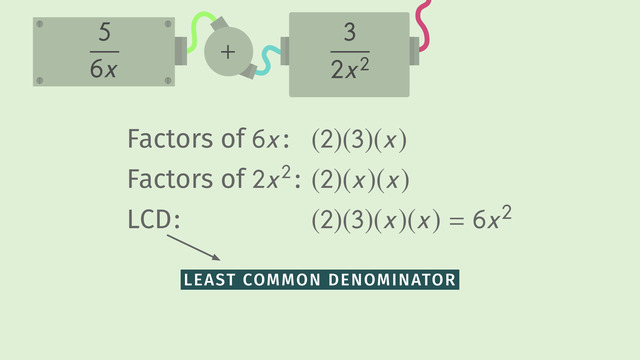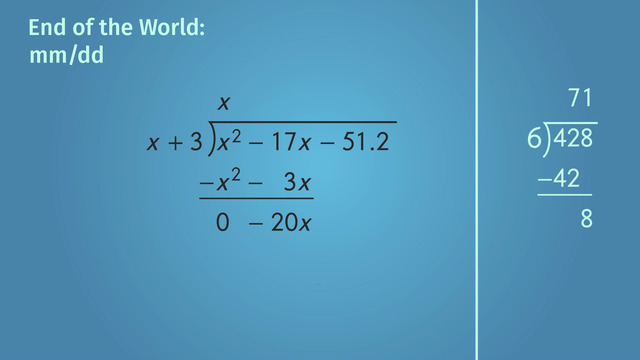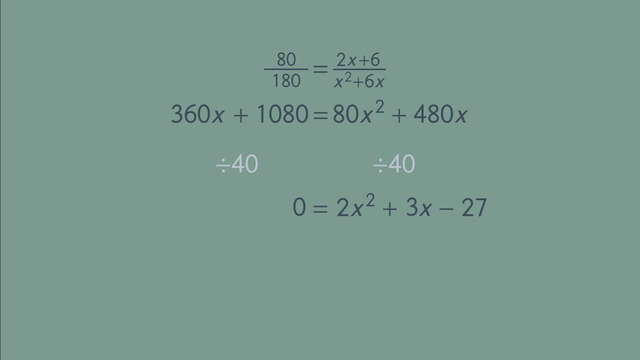Simplifying Rational Expressions

Basics on the topic Simplifying Rational Expressions
Simplifying rational expressions is a similar process to finding the lowest term of a fraction, as rational expressions are nothing more than fractions in which the numerator and the denominator are polynomials. To simplify a rational expression, factor both the numerator and the denominator as much as possible, then cancel out any common factors of the numerator and denominator, and then simplify the expression and rewrite it as a new rational expression. Learn more about how to simplify rational expressions by helping Bender ask Molly to dance at the Main North Middle School's end-of-year dance. Common Core Reference: CCSS.MATH.CONTENT.HSA.APR.D.6
Transcript Simplifying Rational Expressions
This is the scene at Main North Middle School's end-of-year dance. Perhaps not surprisingly, no one is mingling! All the boys are on one side of the cafeteria, while all the girls are hanging out on the other. This is Molly, she´s a bit complicated and hopes Bender will ask her to dance. This is Bender. He has a mad crush on Molly, but he thinks girls are really complicated and hard to understand.
Luckily for Bender, his friend Brian has some experience with simplifying rational expressions and can be Bender's wingman. Let's take a look at what's got Bender so confused about Molly. It’s a rational expression! It looks like a fraction but remember, a fraction bar can be though of as a division sign. 32x squared divided by 24x.
Greatest Common Factors
It's helpful to determine the greatest common factors that make up the numerator and denominator. In the numerator, we can see that 8 times 4 is 32, also 'x' times 'x' is 'x' squared. Moving on to the denominator, we can split 24 into the factors 8 and 3.
Simplifying the Rational Expression
Now comes the fun part. To simplify, we just need to cancel out the terms that appear in both the numerator and the denominator. Once you get to a point where you can't cancel anything else out, you're done!
Matching Binomial Pairs
Another way to simplify expressions is to look for matching binomial pairs. Since the numerator is already simplified, Bender can use reverse FOIL to factor the trinomial in the denominator. Bender's tempted to try to factor out the minus 5 in the numerator, but then he remembers his teacher saying that you CANNOT factor out any numbers added or subtracted to a variable term - you can only factor out an entire polynomial factor. Cancel out any terms that repeat in the numerator and denominator because any number divided by itself is equal to one.
Example of Simplifying Rational Expressions
Bender feels more confident. He wants to try another expression. Molly's expression looks tough, but Bender thinks he's got what it takes to figure her out, her rational expression, of course. There's a binomial in the numerator and a trinomial in the denominator, but he uses the same strategy Brian showed him. Bender notices a greatest common factor in the numerator and a different GCF in the denominator.
First, factor out the GCFs from the terms in the numerator and denominator, respectively. The numerator is good to go, for now. Next, use reverse FOIL to factor the trinomial in the denominator. Bender cancels out any factors that repeat in both the numerator and the denominator because any factor divided by itself is equal to one, including polynomial factors. Bender is finally understanding how to simplify rational expressions! He feels awesome and his confidence is soaring!
Now that Bender understands how to simplify rational expressions, he thinks he has a chance at understanding girls, so he asks Molly to dance, but there's only one problem, he doesn't know how to dance. Sorry, Bender, we can't help you with that.
Simplifying Rational Expressions exercise
-
Explain how to simplify the following expression.
HintsYou can only cancel out common factors of the numerator and the denominator. For example,
$\frac{(2)(3)(x)(y)}{(3)(y)(5)}=\frac{(2)(\not 3)(x)(\not y)}{(\not 3)(\not y)(5)}=\frac{2x}{5}$.
You can cancel out the greatest common factor:
$\frac{(3)(x)(y)}{(3)(x)}=\frac{(\not 3)(x)(y)}{(\not 3)(x)}=\frac{(x)(y)}{(x)}=\frac{(\not x)(y)}{(\not x)}=y$.
SolutionTo simplify rational expressions we first have to look for the greatest common factor of the numerator and the denominator.
First we factor the numerator $32x^2=(8)(4)(x)(x)$ and the denominator $24x=(8)(3)(x)$, and we can then see that the greatest common factor is $(8)(x)$.
We can then cancel out the greatest common factor, to get:
$\frac{32x^2}{24x}=\frac{(8)(4)(x)(x)}{(8)(3)(x)}=\frac{(\not 8)(4)(\not x)(x)}{(\not 8)(3)(\not x)}=\frac{4x}{3}$.
-
Simplify the rational expression.
HintsYou can check a factorization by using the distributive property.
Let's have a look at the following example: $9x+12x^2=(3x)(3+4x)$.
The other way around we get
$(3x)(3+4x)=(3x)(3)+(3x)(4x)=9x+12x^2$ $~~~~~$✓
The FOIL method is a way of remembering the order of multiplying two binomials:
$(x+3)(x+4)=x^2+4x+3x+12=x^2+7x+12$.
To factor a quadratic expression, $x^2+bx+c$, look for the factors of $c$ which sum to $b$.
SolutionFirst we look at the numerator; we factor out $6x^2$ to get $6x^3+42x^2=(6x^2)(x+7)$.
Next we factor the denominator:
- Factoring out $2$ we get $2x^2+26x+84=(2)(x^2+13x+42)$.
- We look for the factors of $42$ which sum to $13$, which are $6$ and $7$. Thus we have that $x^2+13x+42=(x+7)(x+6)$.
$\frac{6x^3+42x^2}{2x^2+26x+84}=\frac{(6x^2)(x+7)}{(2)(x+7)(x+6)}=\frac{3x^2}{x+6}$.
-
Decide the terms to be cancelled out.
HintsNever cancel out any number added or subtracted to a variable term.
You can only cancel out factors which appear in both the numerator and the denominator.
Let's have a look at the example beside: the factors $2$ as well as $a$ are common factors of the numerator and denominator, so they can be cancelled out.
SolutionRemember, you cannot cancel out any numbers added or subtracted to a variable term. You can only cancel out entire polynomial factor.
- $\frac{(3)(4)(x)(z)}{(4)(x)(y)}=\frac{(3)(\not 4)(\not x)(z)}{(\not 4)(\not x)(y)}=\frac{3z}y$
- $\frac{(x+3)(x+1)(z)}{(3)(x+1)(z)}=\frac{(x+3)(x \not +1)(\not z)}{(3)(x \not +1)(\not z)}=\frac{x+3}3$. One cannot simplify this expression any further, as $3$ appears as a summand in the numerator.
- $\frac{(x+5)(x+5)(x+2)}{(5)(6)(x+5)}$. Here, one can only cancel out the binomial $x+5$ to get the resulting rational expression, $\frac{(x+5)(x+2)}{30}$.
-
Determine the simplified rational expression.
HintsYou can factor a difference of squares in the way you see beside.
To factor a trinomial, $x^2+bx+c$, find the factors of $c$ which sum to $b$.
Using the distributive property, the resulting rational expression is given by $\frac{7x-14}{3x+3}$.
SolutionFirst we look at the numerator and factor out $42$ to get $42x^2-168=(42)(x^2-4)$. The binomial inside the parentheses is the difference of two squares, $x^2-2^2$. This can be written as the product of two binomials, $x^2-2^2=(x+2)(x-2)$.
Next we investigate the denominator. Factoring out $18$ gives us
$18x^2+54x+36=(18)(x^2+3x+2)$.
To factor the trinomial we use reverse FOIL; we look for the factors of $2$ which sum to $3$, namely $1$ and $2$. This gives us
$x^2+3x+2=(x+1)(x+2)$.
Looking at the numbers $42$ in the numerator and $18$ in the denominator, we recognize the common factor $6$. Thus we rewrite the expression above as follows:
$\frac{42x^2-168}{18x^2+54x+36}=\frac{(6)(7)(x+2)(x-2)}{(3)(6)(x+1)(x+2)}$.
Now we can realize the greatest common factor, $(6)(x+2)$, which we cancel out to get
$\frac{(6)(7)(x+2)(x-2)}{(3)(6)(x+1)(x+2)}=\frac{(7)(x-2)}{(3)(x+1)}$.
We still use the distributive property to get
$\frac{(7)(x-2)}{(3)(x+1)}=\frac{7x-14}{3x+3}$.
This expression can't be simplified further, so we are done.
-
Describe what can be done to simplify rational expressions.
HintsFor example, $\frac{3+5}5=\frac85$.
Using FOIL multiplication, we have that $(x-5)(x-5)=x^2-5x-5x+25=x^2-10x+25$.
If you divide $2$ by $2$ you get $1$.
SolutionAnother way of simplifying expressions is to look for matching binomial pairs.
Let's have a look at the following expression: $\frac{x-5}{x^2-10x+25}$.
The numerator is already simplified. The denominator can be factored: $x^2-10x+25=(x-5)(x-5)$.
One can't cancel out $-5$; you can only cancel out entire polynomial factors.
We can cancel out $x-5$ to get $\frac{x-5}{x^2-10x+25}=\frac{x-5}{(x-5)(x-5)}=\frac1{x-5}$.
Keep in mind that any number divided by itself is equal to $1$.
-
Examine if the given rational expressions can be simplified.
HintsFactoring the difference of two squares in general looks like $a^2-b^2=(a+b)(a-b)$.
You can only cancel out entire polynomials as a factor.
You can factor a quadratic expression $x^2+bx+c$ by looking for the pairs of factors of $c$ which sum to $b$.
SolutionLet's start with $\frac{6x^2+4x}{3x^2+5x+2}$:
- Factor $2x$ out of the numerator to get $6x^2+4x=(2x)(3x+2)$.
- Use reverse FOIL to factor the denominator, $3x^2+5x+2=(3x+2)(x+1)$.
$\frac{6x^2+4x}{3x^2+5x+2}=\frac{(2x)(3x+2)}{(3x+2)(x+1)}=\frac{2x}{x+1}$.
Next we examine $\frac{3x^3+3x^2}{x^3+2x^2+x}$:
- $3x^3+3x^2=(3x^2)(x+1)=(3x)(x)(x+1)$.
- $x^3+2x^2+x=(x)(x^2+2x+1)=(x)(x+1)(x+1)$.
$\frac{3x^3+3x^2}{x^3+2x^2+x}=\frac{(3x)(x)(x+1)}{(x)(x+1)(x+1)}=\frac{3x}{x+1}$.
Now we have $\frac{4x^2}{2x^2+4x}$;
- $4x^2=(2x)(2x)$.
- $2x^2+4x=(2x)(x+2)$.
$\frac{4x^2}{2x^2+4x}=\frac{(2x)(2x)}{(2x)(x+2)}=\frac{2x}{x+2}$.
The last expression is $\frac{4x^2-8x}{x^2-4}$:
- $4x^2-8x=(4x)(x-2)$.
- $x^2-4=x^2-2^2=(x+2)(x-2)$.











